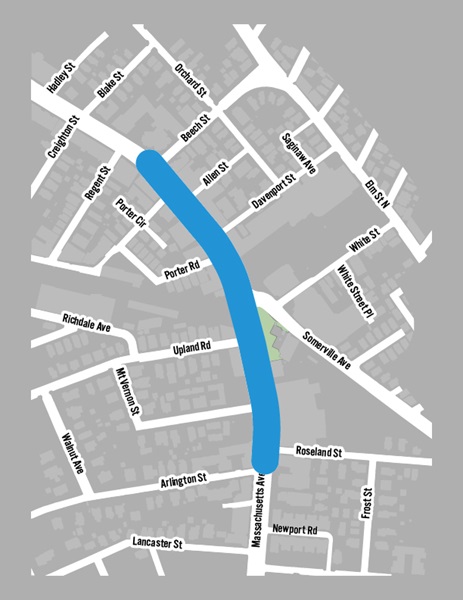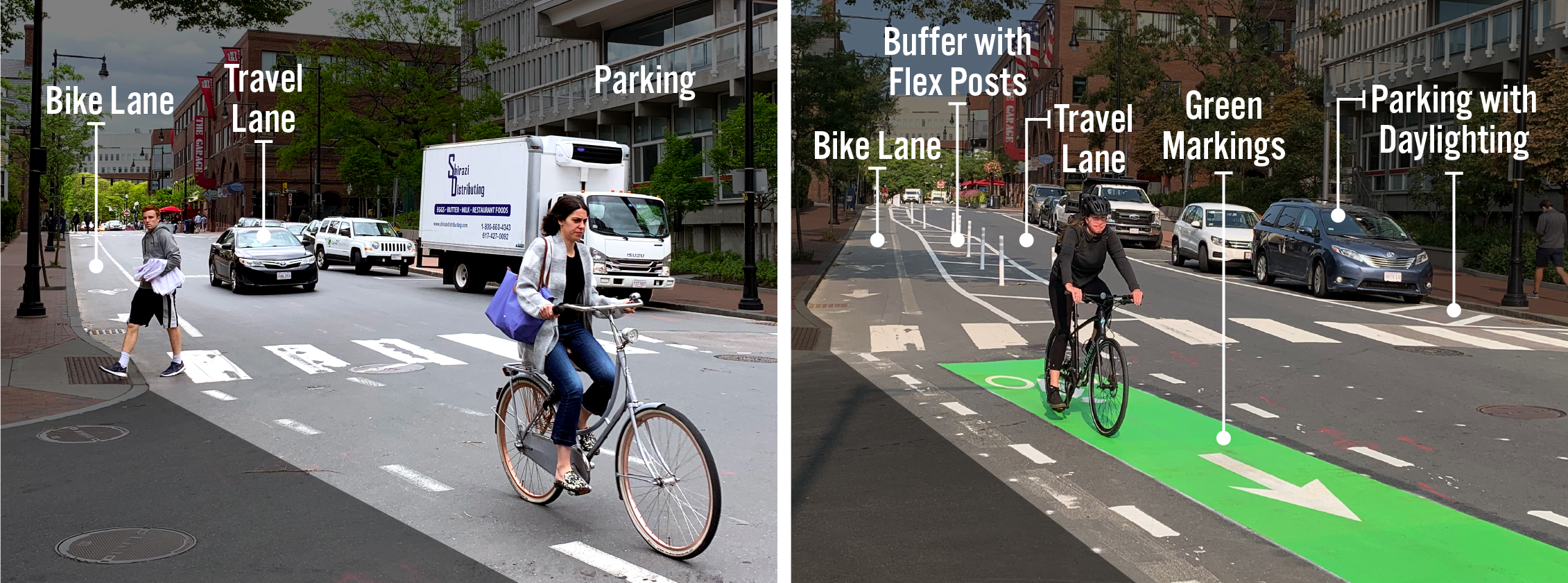
The project area includes the stretch of Massachusetts Avenue from Beech Street to Roseland Street.
Below is a list of frequently asked questions (FAQ) concerning the installation of Quick-Build separated bike lanes in Porter Square this Spring.
1. How much parking are you removing?
Below is the existing parking supply between Beech St and Roseland St.
|
2-Hour Metered Parking
|
35 spaces
|
|
Accessible (Disability) Parking
|
2 spaces
|
|
Loading Zone
|
2 spaces
|
|
Valet
|
2 spaces
|
|
Taxi Stand
|
2 spaces
|
At this relatively early stage of the project, we cannot say for sure what the final impacts will be. However, it is highly likely that all 2-hour parking spaces on Mass Ave will be removed. Some of these spaces could be relocated to side streets. We will know more regarding the impact to loading zones, the taxi-stand and impacts to the hotel valet as we get further along in the design and outreach process. Accessible/disability spaces will be maintained at or near their current locations wherever possible.
2. How does this project reduce injuries and increase safety? I would like to see more cyclists obey traffic laws.
Extensive research has shown that separated bike lanes improve user behavior and increase safety. For example, the current design incentivizes bicyclists to run red lights to avoid clusters of vehicles in traffic, or to ride on the sidewalk, further from vehicles. When safe, separated lanes are created, these negative behaviors are reduced. This is referred to as a Safe Systems Approach, which focuses on structural change, rather than the admonishment of individual behaviors. More information on the Safe Systems Approach, including sources, can be found here.
3. Can you provide more data on bus delay?
In 2018, the City studied bus delay and unreliability on most bus routes in Cambridge. We rated sections of streets on a scale from A to F based on how much delay, unreliability, and number of bus passengers. Any section rated as a D, E or F, was identified as a location of concern where bus delay and unreliability are high. In locations of concern, we may install dedicated bus lanes and priority at signals for buses. These locations of concern are mapped onto Cambridge streets. Click here to see a map of the locations of concern.
We identified all of Mass Ave north of Harvard Square as an area of concern. Within the section from Roseland St to Beech St, the worst delay and unreliability currently occurs in the Northbound direction. The 2018 study gave this section an F rating. There was significant delay, variability, and high ridership. The Southbound direction received a D rating.
4. Are you doing the same thing on other sections of Mass Ave?
Different sections of Mass Ave follow different timelines. Some, such as Porter Square from Beech Street to Roseland Street, are quick-build, while others may be done using a mix of construction and quick-build materials.
There are four segments of Mass Ave that have unique complicating factors including significant underground utility considerations, major bus stops and the MBTA’s electric catenary which presents significant overhead and subsurface utility considerations. These four sections, collectively referred to as MassAve4, are on a longer timeframe. The City conducted an impact analysis on MassAve4 that was published in April 2021.
Conceptual design and construction feasibility is underway for the sections of Mass Ave from Dudley Street to Beech Street and Roseland Street to Waterhouse Street. We began the community process in November 2021. Information about the ongoing work, including the November 2021 video presentation, can be found here.
5. Will there be a construction project after the quick-build project is complete? Can you remove the median or consider sidewalk-level bike lanes in the future?
While the quick-build design does not preclude a construction project in the future, no such project is currently programmed in the city’s 5-year capital plan. Through the MassAve4 process, the City is evaluating existing overhead and underground utilities, as well as other significant subsurface conditions such as the presence of cobblestones and/or abandoned trolley tracks. A thorough understanding of existing conditions is necessary to evaluate the constructability of surface infrastructure changes such as median removal and sidewalk-level bike lanes. For example, changes to a curb line to add a sidewalk-level bike lane would require movement of the catch basins to accommodate drainage. Moving the curb could also trigger a significant amount of construction both above and below ground (e.g., relocation/upgrades to public and private utilities such as water or sewer pipes, gas mains, electrical and telecommunication duct banks, relocation of traffic signals and street lighting), and full depth roadway reconstruction.
Infrastructure projects of this scale usually take 2 to 3 years of careful planning and design, at least two years to construct, and are significantly more expensive than quick-build projects. The outcome is beneficial to the community, but the required construction activities are impactful and must be thoughtfully managed. An example of a major reconstruction project is Western Avenue. There were significant subsurface utility upgrades required to separate stormwater from the sewer system. Due to the extent of the subsurface construction, the city was able to implement major surface infrastructure changes, including a sidewalk-level bike lane.
6. Are you incorporating the feedback from business owners and lessons from previous projects?
Our goal is to speak to every business owner along the corridor and learn how to best meet their needs. We are also considering changes in roadway markings and signage based on lessons learned from previous projects. More details regarding this information will be shared at the second community meeting.
One of the major benefits of quick-build project is the ability to adapt quickly and make further changes. We will work with all stakeholders both before and after implementation and make adjustments if needed.
7. Is the City of Cambridge considering other types of bike lane separation than the white flex posts?
Flex posts are currently the City’s preferred separation type for Quick-Build Projects. Flex posts offer several benefits, such as:
- Relatively easy and inexpensive to procure
- Allow for easy maintenance and street sweepers and plows can navigate in and around the posts
- Reflective elements enhance their visibility at night
- Emergency vehicles such as fire trucks can drive over them if necessary
We are actively exploring additional types of separation, including concrete barriers, or other types of prefabricated materials. Any new separation type shall adhere to a variety of standards related to maintenance, crash tolerance, safety and aesthetics. However, at this moment we envision using flex posts for the foreseeable future, including for the Porter Square project.
Mt Auburn St at Holyoke St - Before and After
The images below show Mt Auburn St at Holyoke St before and after separated bike lanes were installed as a part of the Inner Mount Auburn Safety Improvement Project.

Key Components of Separated Bike Lanes
- Bike lanes create dedicated space for people who are biking.
- Buffers (painted lines on the street) create space between people biking and people driving. They help prevent unintentional collisions that could cause serious harm to the people involved. Depending on the location, there may be a parking lane next to the buffer area. In these instances, drivers can use the buffer area to safely get in and out of the car and to load and unload items.
- Flex posts are placed in the buffer area and serve as a vertical barrier in the buffer area.
- Travel lanes allow space for people to drive down the street, but can be used by anyone.
- Green markings help alert people turning from the travel lane that they should look out for people on bikes. These are generally installed at intersections and across driveways.
- Parking creates space for people to store their vehicles while they are in the area. This part of the street may also be designated as loading zones, which help make it easier for delivery people to do their jobs.
- Daylighting is when the parking lane is pulled back 20 feet to make it easier for people driving down the street and people waiting to cross the street to see each other. These areas are generally marked with lines on the ground. There may also be flex posts.
Why Install Separated Bike Lanes
Separated bike lanes provide more space and vertical separation between people on bikes and people in cars. More people are comfortable biking in separated bike lanes than in traditional bike lanes or in traffic with cars, buses, and trucks. Separated bike lanes also increase safety for people walking by reducing crossing distances. As we install separated bike lanes, we also look for opportunities to increase visibility at intersections, refresh crosswalk markings, and install appropriate pedestrian crossing signs.